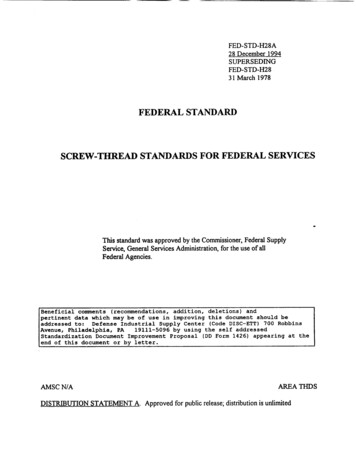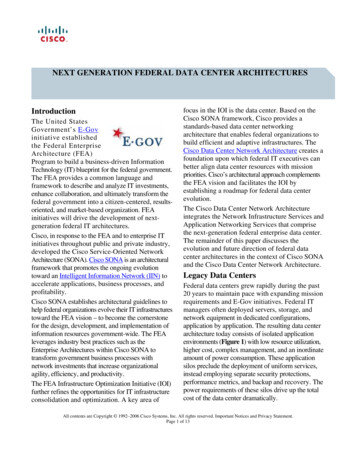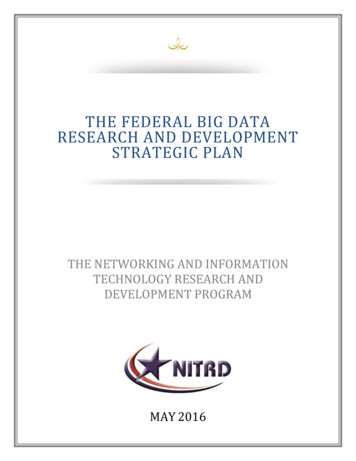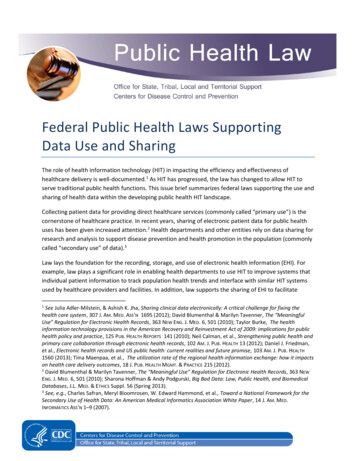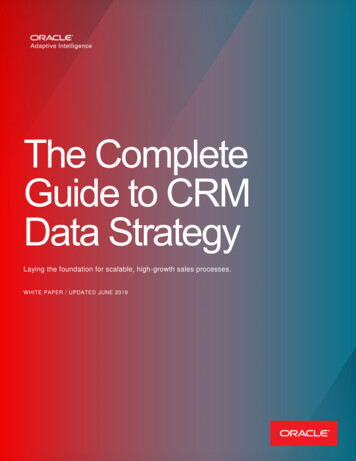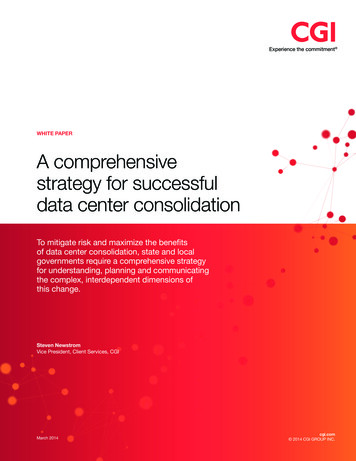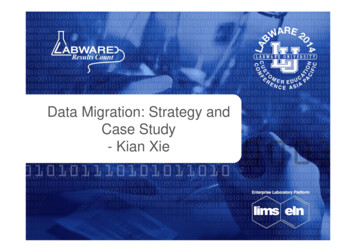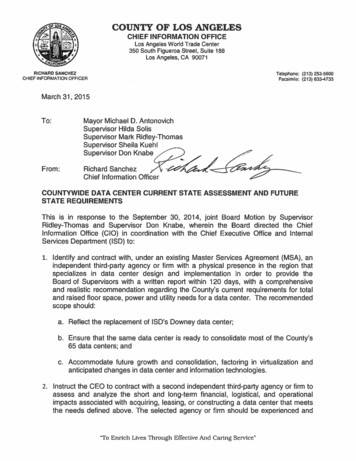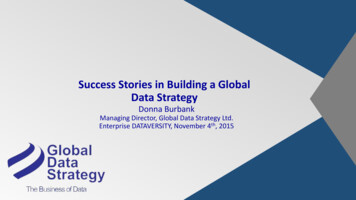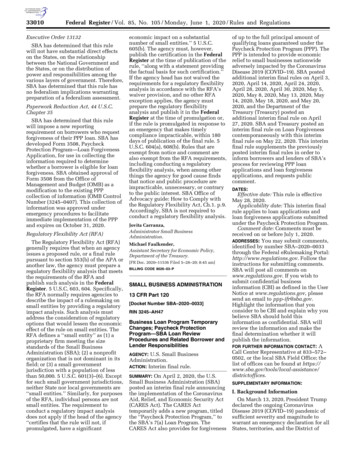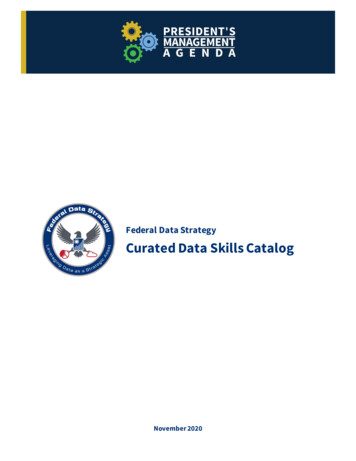
Transcription
Federal Data StrategyCurated Data Skills CatalogNovember 2020
Federal Data StrategyCurated Data Skills CatalogTable of ContentsOVERVIEW AND PURPOSE . 3DEVELOPMENT PROCESS . 3FEDERAL DATA LIFECYCLE AND ASSOCIATED SKILLS. 4FEDERAL DATA LIFECYCLE . 4ROLES AND S KILLS . 7Overarching Concept and Skills. 7Data Roles and Skills . 8Other Roles and Skills . 12FEDERAL LEARNING OPPORTUNITIES . 13RESOURCES AVAILABLE TO THE PUBLIC (INCLUDING ALL FEDERAL EMPLOYEES) . 14CENSUS ACADEMY . 14US GEOLOGICAL S URVE Y DATA MANAGEME NT T RAININGS . 15RESOURCES AVAILABLE TO SELECT FEDERAL EMPLOYEES . 16CHIEF INFORMATION OFFICER (CIO) COUNCIL DATA S CIENCE T RAINING PROGRAM . 16EVALUATION AND EVIDENCE T RAINING S ERIES . 17T HE HHS D ATA S CIENCE COLAB . 18T HE T REASURY EXECUTIVE INSTITUTE (TEI). 19APPENDIX A . 20D EVELOPMENT OF THE FEDERAL DATA LIFECYCLE . 20APPENDIX B . 21CROSSWALK OF FDS PRACTICES AND FEDERAL DATA LIFECYCLE ROLES . 21APPENDIX C . 26CHIEF INFORMATION OFFICER (CIO) COUNCIL DATA S CIENCE T RAINING PROGRAM C URRICULUM . 26APPENDIX D. 32S ELECT FY2021 EVALUATION AND EVIDENCE T RAINING S ERIES COURSES . 32APPENDIX E . 33T HE T REASURY EXECUTIVE INSTITUTE (TEI) MEMBERS FY20. 33APPENDIX F . 35T HE T REASURY EXECUTIVE INSTITUTE (TEI) S ELECT FY20 DATA COURSES . 35STRATEGY.DATA.GOVPage 2RESOURCES.DATA.GOV
Federal Data StrategyCurated Data Skills CatalogOverview and PurposeImproving staff data skills will allow agencies to better harness the power of data. To help Agenciesaddress this need, Action 13 of the Federal Data Strategy (FDS) 2020 Action Plan called for thedevelopment of a curated data skills catalog (Catalog). This catalog offers a common vocabulary of dataroles and skills in the Federal data ecosystem. It highlights examples of governmental learningopportunities to help agencies develop staff data competencies within the Federal Data Lifecycle. TheCatalog can also help agencies develop training programs by highlighting existing governmentresources and curricula.Increasing agency staff data capabilities supports the implementation of both the Evidence Act andrelated guidance 1-3 as well as the Executive Order on Maintaining American Leadership in ArtificialIntelligence, 4 both of which require an assessment of staff capacity for various data-related functions.The Catalog consists of two parts: Federal Data Lifecycle and Associated Skills, providing a common vocabulary of the dataroles and skills in the Federal data ecosystem. Federal Learning Opportunities, detailing select existing Federal data training and courses.Development ProcessThis Catalog is intended to help agencies develop competencies for managing data as a strategic assetand making data-driven decisions. The 2020 Action Plan specifically tasked the General ServicesAdministration (GSA) with leading Action 13. A focus group of data experts from across 9 Federalagencies was convened to determine the significant roles in the data ecosystem within the Federalgovernment, list skills affiliated with these key functions, and create the Catalog. 5The Catalog was released in multiple stages to allow useful content to be available as soon as it wasready rather than in a single, delayed release. The contents of the Catalog have initially been availableto the Chief Data Officers (CDOs) of each agency as well as other relevant Federal communities as it wasbeing built. This allowed Federal stakeholder input to be incorporated early in its design. Non-Federalinput was also obtained and included prior to its final release. Demand for data skills identified in otherparts of the FDS, including Action 4, have also informed the priorities for how the Catalog was built. TheCatalog will be transferred to the CDO Council after December 31, 2020.1Foundations for Evidence-Based Policymaking Act of 2018, Pub. L. No. 115-435, 132 Stat. 5529.OMB M-19-23, Phase 1 Implementation of the Foundations for Evidence-Based Policymaking Act of 2018:Learning Agendas, Personnel, and Planning Guidance, July 10, 2019, found at: df.3 The Evidence Act also requires a capacity assessment, which in part determines “the extent to which evaluationand research capacity is present within the agency to include personnel” and “the extent to which the agency hasthe capacity to assist agency staff and program offices to develop the capacity to use evaluation research andanalysis approaches and data in the day-to-day operations.” Please refer to OMB M-19-23 and OMB Circular A-11for more information on this requirement.4 ficialintelligence/5 The focus group convened to create the Federal Data Lifecycle is described in Appendix A.2STRATEGY.DATA.GOVPage 3RESOURCES.DATA.GOV
Federal Data StrategyCurated Data Skills CatalogFederal Data Lifecycle and Associated SkillsFederal Data LifecycleThis Lifecycle offers a common vocabulary for agencies to understand and evaluate data roles andskills. The Federal Data Lifecycle adapts the NIST Big Data Reference Architecture 6 and links subsequentdata roles with the established FDS practices. The framework below lays out a variety of roles for thoseinvolved in data and provides the conventional responsibilities for each role. These include datafocused roles7 and others in the organization such as leadership and domain experts. This frameworkcan be helpful with assessing staff data skills and creating training programs to bridge any gaps.The required data skills, whether technical skills associated with analysis, ‘softer’ skills associated withcommunication and coalition building, or otherwise are given for each of the roles beginning on page7. FDS practices are related to many of these data roles, and a crosswalk of FDS Practices and theFederal Data Lifecycle provides further details of this connection in Appendix B.Figure 1: Federal Data Lifecycle6U.S. Department of Commerce. National Institute of Standards and Technology (NIST). NIST Big DataProgram. Retrieved from .SP.1500-6r2.pdf.7Agency personnel in data-focused roles as well as staff that access data need to have a basicunderstanding of their agency’s cybersecurity and privacy policies that govern data and need to workclosely with their agency experts in cybersecurity and privacy throughout the Federal Data Lifecycle.More inf ormation on the Federal Information Security Modernization Act of 2014 can be found dfSTRATEGY.DATA.GOVPage 4RESOURCES.DATA.GOV
Federal Data StrategyCurated Data Skills CatalogFigure 2. Federal Data Lifecycle rolesOverarching Concept Ensure Privacy and Security: Ensure that agencies are consistently adopting and using themost up-to-date methods to protect data and comply with all applicable laws and regulationsData Roles Define: Identify agency and stakeholder needs for data of sufficient quality for intended uses Coordinate: Assess the ability of data resources and infrastructure to meet agency andstakeholder needs Collect: Organize, plan, and execute data collections and acquisitions to meet agency andstakeholder needs Curate: Organize, refine, validate, and maintain agency data resources with sufficient qualityto meet agency and stakeholder needs Access: Identify and develop multiple data access methods for agency staff and stakeholders Analyze: Optimize the ability of staff and stakeholders to use agency data to generate insights Visualize: Present data insights for consumption by leaders and stakeholders Disseminate: Provide multiple avenues for release of data and insights Implement & Assess: Maximize the use of data for decision-making, accountability, and thepublic good and continuously improving the data process to address problems with datacollection/measurement, processing, and analysesOther Roles Leadership: Cultivate and support a culture of enterprise-wide demand and use of data tomaximize outcomes Domain Expert: Understands the context around the data, the needs of all involvedstakeholders, and often takes on many roles throughout the process in an advisory or leadcapacity to inform collection, data systems, data dictionaries, data set design, and analysis All Others: Each staff member values the use of data in their day-to-day workSTRATEGY.DATA.GOVPage 5RESOURCES.DATA.GOV
Federal Data StrategyCurated Data Skills CatalogSelect Statutory authority and policy guidance related to data The Federal Records Act of 1950Privacy Act of 1974Paperwork Reduction Act (PRA) of 1995Information Quality Act of 2001Federal Information Security Modernization Act of 2014 (FISMA) Public Law 113–283 (2014)Geospatial Data Act of 2018Foundations for Evidence-Based Policymaking Act of 2018 (Evidence Act) – Public Law115–435 (2019)o TITLE I—FEDERAL EVIDENCE–BUILDING ACTIVITIESo TITLE II—OPEN GOVERNMENT DATA ACTo TITLE III—CONFIDENTIAL INFORMATION PROTECTION AND STATISTICALEFFICIENCYOMB Memorandum M–19–15 Improving Implementation of the Information Quality Actissued on April 24, 2019. /04/M19-15.pdfOMB Memorandum M–19–21 Transition of Electronic Records issued on June 28, /2019/08/M-19-21-new-2.pdfOMB Memorandum M–19–23 Phase 1 Implementation of the Foundations for EvidenceBased Policymaking Act of 2018: Learning Agendas, Personnel, and Planning Guidanceissued on July 10, 2019. /07/M-1923.pdfSTRATEGY.DATA.GOVPage 6RESOURCES.DATA.GOV
Federal Data StrategyCurated Data Skills CatalogRoles and SkillsOverarching Concept and SkillsOverarching ConceptSkillsEnsure Privacy and Security: Ensure that agencies areconsistently adopting and using the most up-to-datemethods to protect data and comply with allapplicable laws and regulationsAgency personnel in data-focused roles aswell as staff that access data need to have abasic understanding of their agency’scybersecurity and privacy policies thatgovern data as well as data ethicsprinciples, and need to work closely withtheir agency experts in cybersecurity,privacy, and ethics throughout the FederalData LifecyclePractices11. Prioritize Data Governance12. Govern Data to Protect Confidentiality and Privacy13. Protect Data IntegritySTRATEGY.DATA.GOVPage 7RESOURCES.DATA.GOV
Federal Data StrategyCurated Data Skills CatalogData Roles and SkillsData RoleSkills Communication Knowledge of requirements for informationcollection review approvals including datarequirements and business rules Performance metrics Planning Problem solving Strategic planning Strategic thinking TeamworkDefine: Identify agency and stakeholder needs fordata of sufficient quality for intended usesPractices1. Identify Data Needs to Answer Key AgencyQuestions2. Assess and Balance the Needs of Stakeholders28. Align Quality with Intended UseDomain Expert input is important at this stepCoordinate: Assess the ability of data resources andinfrastructure to meet agency and stakeholderneedsPractices1. Identify Data Needs to Answer Key AgencyQuestions8. Monitor and Address Public Perceptions9. Connect Data Functions Across Agencies10. Provide Resources Explicitly to Leverage DataAssets15. Assess Maturity16. Inventory Data Assets17. Recognize the Value of Data Assets18. Manage with a Long View19. Maintain Data Documentation20. Leverage Data Standards21. Align Agreements with Data ManagementRequirements36. Leverage Partnerships37. Leverage Buying Power38. Leverage Collaborative Computing PlatformsSTRATEGY.DATA.GOV Business acumenCoalition buildingCommunicationFederal enterprise architecture framework (FEAF)Data modellingHorizon scanningKnowledge of data archiving and preservationstandardsKnowledge of data standardsKnowledge of novel data sources and collectionmethodsKnowledge of requirements for informationcollection review approvalsKnowledge of the budget processPlanningProblem solvingRelationship buildingStrategic thinkingDomain Expert input is important at this stepPage 8RESOURCES.DATA.GOV
Federal Data StrategyCurated Data Skills CatalogData RoleCollect: Organize, plan, and execute datacollections and acquisitions to meet agency andstakeholder needsPractices23. Allow Amendment25. Coordinate Federal Data Assets26. Share Data Between State, Local, and TribalGovernments and Federal Agencies29. Design Data for Use and Re-Use30. Communicate Planned and Potential Uses ofDataCurate: Organize, refine, validate, and maintainagency data resources with sufficient quality tomeet agency and stakeholder needsPractices16. Inventory Data Assets19. Maintain Data Documentation20. Leverage Data Standards21. Align Agreements with Data ManagementRequirements24. Enhance Data Preservation32. Harness Safe Data Linkage33. Promote Wide AccessSkills Basic computer literacy Collecting new source data such as through webscraping Communication Developing MOUs and Interagency Agreements Frame development, questionnaire/instrumentdevelopment Interpersonal Knowledge of Federal Data Collection Authorities Knowledge of requirements for informationcollection review approvals Real-time or near real-time collection methods Reviewing existing data for potential new uses Sampling design Big data technologies Data storage and preservation Data warehouse/architecture design, development,construction, and maintenance Develop scalable extract, transform, and load (ETL)processes Information quality control and quality assurancemethods and techniques Knowledge of operating systems Metadata skills including knowledge of theenterprise metadata standards and ability toproduce unambiguous, useful metadata Programming tools Statistics, data checking, and internal controls ondata reporting and quality, consistency, and logicedits Techniques to understand and clean raw andunstructured data (data wrangling) Understand and incorporate stakeholder needsand requirementsDomain Expert input is important at this stepSTRATEGY.DATA.GOVPage 9RESOURCES.DATA.GOV
Federal Data StrategyCurated Data Skills CatalogData RoleSkillsBusiness acumenCommunicationData modeling and transformationData sharing policiesDatabase authentication methodsDisclosure risk limitationFile formatsFundamental computer forensicsIntellectual property rightsMetadata repository development andmaintenance Problem solving Tiered access to data methods Understand stakeholders needs and requirements Access: Identify and develop multiple data accessmethods for agency staff and stakeholdersPractices5. Prepare to Share22. Identify Opportunities to Overcome ResourceObstacles25. Coordinate Federal Data Assets26. Share Data Between State, Local, and TribalGovernments and Federal Agencies31. Explicitly Communicate Allowable Use33. Promote Wide Access34. Diversify Data Access Methods35. Review Data Releases for Disclosure Risk Analyze: Optimize the ability of staff andstakeholders to use agency data to generateinsightsPractices27. Increase Capacity for Data Management andAnalysis31. Explicitly Communicate Allowable Use38. Leverage Collaborative Computing Platforms39. Support Federal Stakeholders40. Support Non-Federal Stakeholders Data conditioning and data miningGenerate dashboards, charts, and graphsGeospatial analysisMachine learning algorithms, artificial intelligence,natural language processing and rapid processautomationMath and statisticsPredictive modeling and projectionsResearch designStrategic communicationTrend or pattern analysisUnderstand metadataSpecialized expertise in the application of data,such as for statistical production or conductingprogram evaluationKnowledge and understanding on applying theappropriate and relevant analysis methods for thequestions posedDomain Expert input is important at this stepVisualize: Present data insights for consumption byleaders and stakeholdersPractices6. Convey insights from data CommunicationData storytellingData visualization (including 508 compliance)Programming or tools to create static or interactivereports, graphics, and dashboardsUnderstand stakeholder needs and requirementsUser experience designWeb design and HTMLSophisticated understanding of what data doesand does not inferDomain Expert input is important at this stepSTRATEGY.DATA.GOVPage 10RESOURCES.DATA.GOV
Federal Data StrategyCurated Data Skills CatalogData RoleSkillsDisseminate: Provide multiple avenues for releaseof data and insightsPractices6. Convey Insights from Data7. Use Data to Increase Accountability14. Convey Data Authenticity30. Communicate Planned and Potential Uses ofData31. Explicitly Communicate Allowable Use33. Promote Wide Access34. Diversify Data Access Methods35. Review Data Releases for Disclosure Risk Implement & Assess: Maximize the use of data fordecision-making, accountability, and the publicgood, and continuously improving the data process Practices2. Assess and Balance the Needs of Stakeholders3. Champion Data Use4. Use Data to Guide Decision-Making7. Use data to Increase AccountabilitySTRATEGY.DATA.GOVAccessibility standards (508 compliance)CommunicationCompanion materials creationData formats and API technologyIntellectual property rightsNegotiationRelationship buildingUnderstand stakeholder needs and requirementsCoalition building and advocate for data useCommunicationData managementProblem solvingQuality manag
The Federal Data Lifecycle adapts 6the NIST Big Data Reference Architecture and links subsequent data roles with the established FDS practices. The framework below lays out a variety of roles for those involved in data and provides the conventional responsibilities for each role. These include data-
